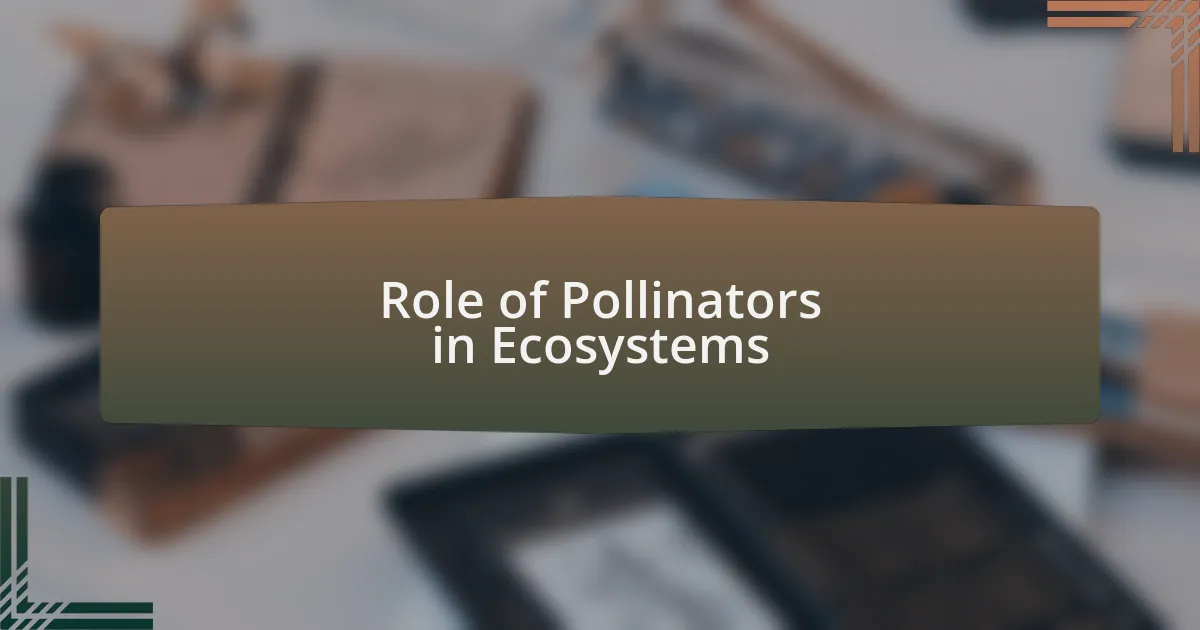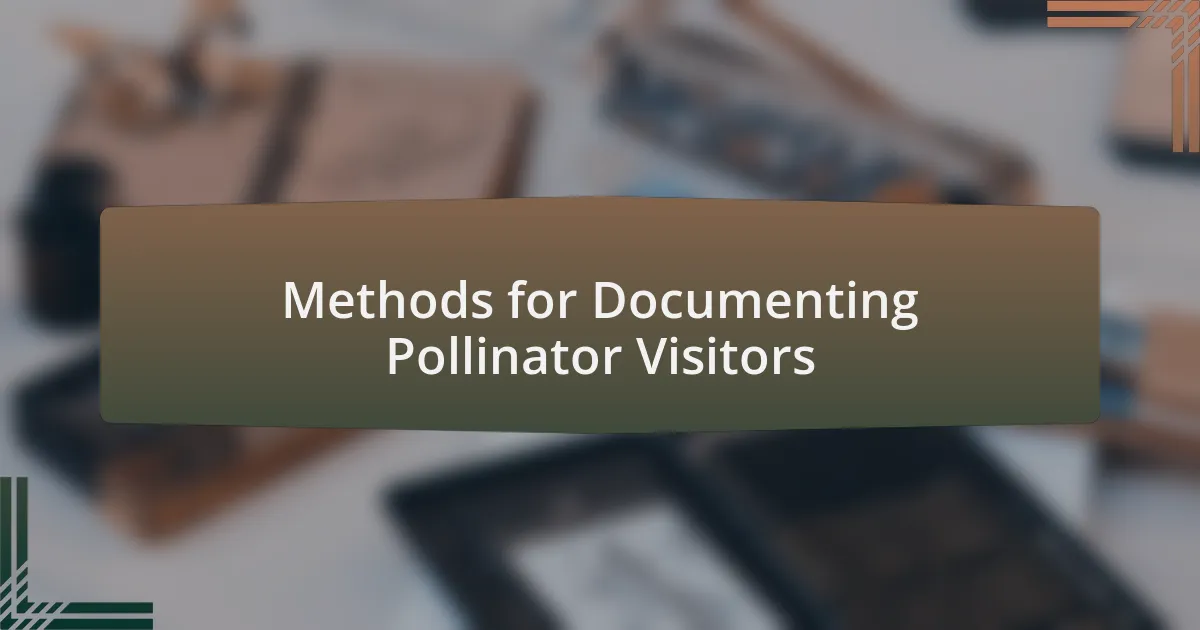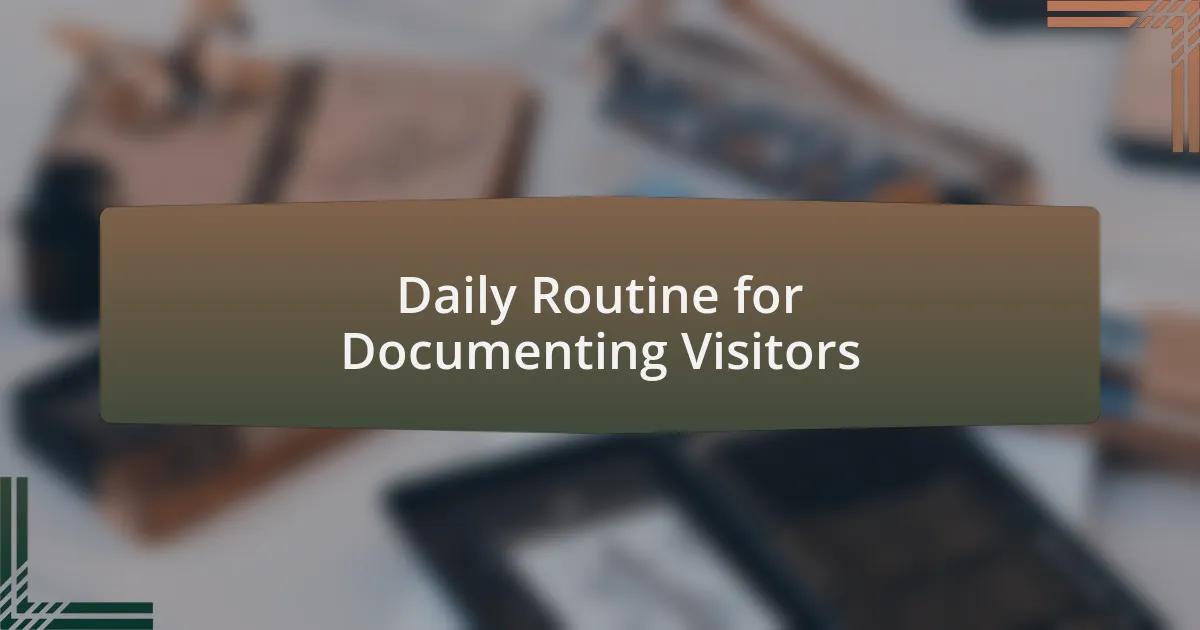Key takeaways:
- Butterflies are essential pollinators that support plant health and biodiversity, highlighting the need for their conservation.
- Observing and documenting butterfly activity can enhance understanding of their behaviors and preferences, contributing to butterfly conservation efforts.
- Choosing observation locations with diverse flowering plants and the right timing can significantly increase the chances of documenting pollinator visits.
- Sharing findings with the community fosters collaboration and assists in broader conservation initiatives, enriching individual and collective knowledge about butterflies.

Understanding Butterfly Conservation Importance
Butterflies play a crucial role in our ecosystems, acting as pollinators and contributing to the health of various plants and flowers. I remember the first time I witnessed the pollination process; it was a warm afternoon filled with color as butterflies flitted from bloom to bloom. Seeing this delicate dance made me realize just how interconnected nature is and how essential butterflies are to the survival of many plant species.
The decline in butterfly populations is alarming and serves as a warning signal about the health of our environment. Have you ever considered how the loss of these pollinators might affect our food systems? When I learned about the impact on crops that rely on butterflies and other pollinators, it hit me personally; we depend on these beautiful creatures more than we might realize.
Conserving butterflies means protecting the habitats they rely on, which ultimately supports biodiversity. I often find myself advocating for local initiatives aimed at creating butterfly gardens. It’s not just a project; it’s a powerful statement about our commitment to preserving these vibrant species and the ecosystems they sustain. When we engage in conservation efforts, we weave ourselves back into the natural world, fostering a sense of responsibility for generations to come.

Role of Pollinators in Ecosystems
The role of pollinators extends far beyond just adding beauty to our gardens; they are essential to food production and the stability of ecosystems. I recall a trip to a local orchard where I saw the thrumming activity of bees and butterflies around the fruit trees. It struck me that without these diligent workers, many fruits would simply not exist. Have you ever pondered what would happen to your favorite berries and apples if we didn’t have pollinators? Their impact on our food supply is profound and often overlooked.
Moreover, pollinators contribute to the genetic diversity of plants by facilitating cross-pollination. I noticed this last summer while observing different flowers in my own backyard; the variances in colors and shapes reminded me of how pollinators silently enable this natural artistry. Each visit they make enhances the resilience of our native flora, ensuring that plants can adapt and thrive in changing environments. Isn’t it remarkable to think that a single butterfly’s delicate touch can lead to such rich biodiversity?
As I delve deeper into the interconnectedness of life, I’m often amazed by the ripple effects of losing pollinators. If these creatures vanish, entire ecosystems stand to be disrupted, affecting not just plants but countless species that depend on them for habitat and food. The weight of this reality can be heavy, but it’s also a call to action for each one of us. How can we turn this knowledge into a force for good? Every effort we make to support pollinators can lead to a healthier ecosystem, and ultimately, a better world for all.

Methods for Documenting Pollinator Visitors
When documenting pollinator visitors, one effective method is to conduct time-lapse observation. I remember placing a camera in my garden last spring, excited to see the flurry of activity throughout the day. This approach not only captured the buzzing bees and fluttering butterflies but also allowed me to analyze their behavior — how long they linger on each flower and which plants attract them the most. Have you ever thought about how observing these patterns could enhance your understanding of their preferences?
Another method that’s been quite rewarding is creating a simple data sheet to log visitor types and numbers. I started this practice after becoming fascinated by the variety of bees and butterflies in my yard. By jotting down my observations alongside photos, I was able to identify patterns over time. This has helped me cultivate a garden that blooms with flowers favored by pollinators, making every visit feel like a small victory in supporting these essential creatures.
Finally, I want to highlight the joy of involving others in your pollinator documentation efforts. I organized a local pollinator count day with friends, which turned into a delightful gathering of nature enthusiasts. Sharing our findings and experiences deepened our appreciation for these visitors and created a sense of community around conservation. Have you considered how collective observation could enrich your own journey in understanding pollinators?

Choosing the Right Observation Locations
Choosing the right observation locations is crucial for effective documentation. I’ve found that areas with a rich diversity of flowering plants tend to attract the most visitors. For instance, when I placed my observation station near a cluster of native wildflowers, I was rewarded with a parade of bees and butterflies. Have you ever wondered how different plants can create vibrant communities of pollinators?
It’s also worth considering the time of day when you set up your observations. I’ve noticed that mornings tend to be the most active times for pollinators, as they emerge to bask in the warmth and search for nectar. One particularly memorable morning, I watched a monarch butterfly dance between blooms, and it struck me how location and timing can significantly impact what you see. Have you ever been surprised by what visits your garden at different times?
Finally, don’t overlook the importance of varied habitats. Whether it’s a sunny patch of garden or the edge of a woodland, each setting offers unique opportunities for encounters. I remember one sunny afternoon in a meadow; I was mesmerized by a group of hoverflies buzzing around. This experience made me realize that exploring different environments broadens the scope of what we can document. What hidden gems could you discover by simply changing your observation spots?
![]()
Tools for Tracking Butterfly Activity
To effectively track butterfly activity, having the right tools can make a world of difference. Personally, I always carry a notebook and a set of colored pens to record my observations. There’s something satisfying about jotting down notes by hand, especially when I capture a fleeting moment, like a vibrant swallowtail resting on a flower. Have you ever paused in your tracks because a butterfly landed nearby, and you wished you could remember every detail?
Another invaluable tool is a smartphone or digital camera. I love snapping photos of butterflies as they flit from flower to flower; it not only helps with identification later but also creates a visual diary of my encounters. I remember vividly when I captured a rare sighting of a painted lady—taking that picture felt like capturing a tiny piece of magic. How many unique stories could your photos tell?
Lastly, consider using butterfly observation apps or online databases. These platforms allow me to log sightings and contribute to citizen science projects, helping researchers understand butterfly populations better. One time, I was thrilled to see that my recorded sightings contributed to a local conservation effort. Isn’t it rewarding to know that your observations can help protect these beautiful pollinators?

Daily Routine for Documenting Visitors
Documenting butterfly visitors is an immersive daily routine that I truly look forward to each day. I start by selecting a consistent spot in my garden to observe which flowers attract the most butterflies. Each morning, as the sun rises, I pour a cup of coffee and settle into my favorite chair with my notebook, excited to see who might flutter by. Isn’t there something peaceful about the stillness of the morning air, broken only by the soft wings of a butterfly?
Throughout the day, I make it a point to step outside every few hours. I employ a simple method: I write down the time and type of butterfly I spot, along with the flowers it’s visiting. One afternoon, I noticed a clouded sulfur delightfully sipping nectar, and I quickly sketched its unique markings in my notebook. Have you ever felt that rush of excitement when you see a butterfly you can hardly identify? It’s moments like these that fuel my passion for documenting these visits.
In the late afternoon, I review my notes and photos from the day. This reflection is essential; it helps me notice patterns over time, like which flowers attract certain species. I remember last summer, when I noticed more monarchs visiting the milkweed I had planted, prompting me to research the best practices for enhancing their habitat. Wouldn’t it be amazing if you could create your own little butterfly sanctuary? Observing this routine not only deepens my connection with nature but also contributes valuable data to butterfly conservation efforts.

Analyzing and Sharing Your Findings
Once I have accumulated all my observations, I dive into analyzing the data. This step can be incredibly rewarding, as I look for trends in species and their preferred flowers. Last season, I discovered that the vibrant zinnias in my garden consistently attracted a range of butterflies, which led me to wonder: what specific qualities do these flowers possess that make them so irresistible?
Sharing my findings is where the magic truly happens. Whether through social media, local conservation groups, or community science platforms, I find joy in discussing my observations with others who share my passion. It feels like I’m not just documenting butterflies; I’m contributing to a larger conversation about their survival. Have you ever uploaded your findings online and felt the excitement of engaging with fellow enthusiasts? The collaborative aspect can offer new insights and foster a sense of camaraderie among butterfly lovers.
In addition to sharing discoveries online, I often craft simple reports summarizing my findings throughout the season. These reports help me reflect on my journey and serve as a useful reference for future explorations. It’s a satisfying way to visualize the impact of my observations, and every butterfly I spot feels like another chapter in this evolving story. With each report, I can’t help but think: how many more stories are waiting to be told, just beyond my doorstep?